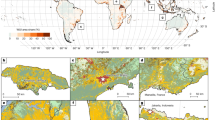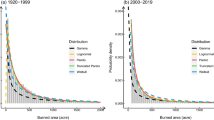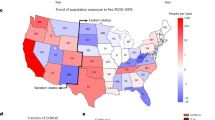Abstract
Intensifying wildfires and human settlement expansion have placed more people and infrastructure at the wildland–urban interface (WUI) areas under risk. Effective wildfire management and policy response are needed to protect ecosystems and residential communities; however, maps containing spatially and temporally explicit information on the distribution of WUI areas are limited to certain countries or local regions, and global WUI patterns and associated wildfire exposure risk therefore remain unclear. Here we generated the global WUI data layers for the 2020 baseline and the 1985–2020 time series by integrating fine-resolution housing and vegetation mapping. We estimated the total global WUI area to be 6.62 million km2. Time-series analysis revealed that global WUI areas increased by 12.56% between 1985 and 2020. By overlapping 2001–2020 wildfire burned area maps and fine-resolution population datasets, our analysis uncovered that globally, 7.07% (12.54%) of WUI areas housing 4.47 million (10.11 million) people are within a 2,400 m (4,800 m) buffer zone of wildfire threat. Regionally, we found that the United States, Brazil, China, India and Australia account for the majority of WUI areas, but African countries experience higher wildfire risk. Our quantification of global WUI spatiotemporal patterns and the associated wildfire risk could support improvement of wildfire management.
This is a preview of subscription content, access via your institution
Access options
Access Nature and 54 other Nature Portfolio journals
Get Nature+, our best-value online-access subscription
$29.99 / 30 days
cancel any time
Subscribe to this journal
Receive 12 digital issues and online access to articles
$119.00 per year
only $9.92 per issue
Buy this article
- Purchase on Springer Link
- Instant access to full article PDF
Prices may be subject to local taxes which are calculated during checkout





Similar content being viewed by others
Data availability
The global hierarchy of administrative unit layers are from the Food and Agriculture Organization of the United Nations (https://data.apps.fao.org). The population dataset is from WorldPop (https://www.worldpop.org). The global baseline land-cover product for 2020 (WorldCover) is from the European Space Agency (https://esa-worldcover.org). The Meta (formerly Facebook) HRPD maps are from the Data for Good platform (https://dataforgood.facebook.com/dfg/tools/high-resolution-population-density-maps). The WSF maps are from the Scientific Data repository (https://www.nature.com/articles/s41597-020-00580-5). The wildfire burned area datasets are from the MODIS data archive in Google Earth Engine (https://earthengine.google.com). The global urban area boundaries are from the FROM-GLC research group (https://data-starcloud.pcl.ac.cn/). The global industrial and smallholder oil palm map is from Zenodo (https://zenodo.org/record/4473715). WUI data in the United States for validation are from the SILVIS lab (http://silvis.forest.wisc.edu/data/wui-change). The 30 m GLC-FCS product is from Zenodo (https://zenodo.org/record/3986872). The 100 m global human settlement layers are from the Joint Research Centre of the European Commission (https://ghsl.jrc.ec.europa.eu/ghs_buS2023.php). The global WUI datasets for the 2020 baseline and 1985–2020 time series have been deposited in the following repository: https://datahub.hku.hk/projects/GlobalWUI/191163.
References
Bond, W. J., Woodward, F. I. & Midgley, G. F. The global distribution of ecosystems in a world without fire. N. Phytol. 165, 525–538 (2005).
Wu, C. et al. Reduced global fire activity due to human demography slows global warming by enhanced land carbon uptake. Proc. Natl Acad. Sci. USA 119, e2101186119 (2022).
Jin, Y. et al. Identification of two distinct fire regimes in Southern California: implications for economic impact and future change. Environ. Res. Lett. 10, 094005 (2015).
Johnston, F. H. et al. Estimated global mortality attributable to smoke from landscape fires. Environ. Health Perspect. 120, 695–701 (2012).
Sanderfoot, O. V. et al. A review of the effects of wildfire smoke on the health and behavior of wildlife. Environ. Res. Lett. 16, 123003 (2021).
Spreading like Wildfire: The Rising Threat of Extraordinary Landscape Fires—a UNEP Rapid Response Assessment, Nairobi (United Nations Environment Programme, 2022).
Yu, Y. et al. Machine learning–based observation-constrained projections reveal elevated global socioeconomic risks from wildfire. Nat. Commun. 13, 1250 (2022).
Chen, B. et al. Climate, fuel, and land use shaped the spatial pattern of wildfire in California’s Sierra Nevada. J. Geophys. Res. Biogeosci. 126, e2020JG005786 (2021).
Andela, N. et al. A human-driven decline in global burned area. Science 356, 1356–1362 (2017).
Gutierrez Aurora, A. et al. Wildfire response to changing daily temperature extremes in California’s Sierra Nevada. Sci. Adv. 7, eabe6417 (2021).
Westerling, A. L., Hidalgo, H. G., Cayan, D. R. & Swetnam, T. W. Warming and earlier spring increase western U.S. forest wildfire activity. Science 313, 940–943 (2006).
Williams, A. P. et al. Observed impacts of anthropogenic climate change on wildfire in California. Earth’s Future 7, 892–910 (2019).
Mueller, S. E. et al. Climate relationships with increasing wildfire in the southwestern US from 1984 to 2015. Ecol. Manage. 460, 117861 (2020).
Holden, Z. A. et al. Decreasing fire season precipitation increased recent western US forest wildfire activity. Proc. Natl Acad. Sci. USA 115, E8349–E8357 (2018).
Stephens, S. L. et al. Drought, tree mortality, and wildfire in forests adapted to frequent fire. Bioscience 68, 77–88 (2018).
Gudmundsson, L., Rego, F. C., Rocha, M. & Seneviratne, S. I. Predicting above normal wildfire activity in southern Europe as a function of meteorological drought. Environ. Res. Lett. 9, 084008 (2014).
Chen, B. & Jin, Y. Spatial patterns and drivers for wildfire ignitions in California. Environ. Res. Lett. 17, 055004 (2022).
Radeloff, V. C. et al. Rapid growth of the US wildland–urban interface raises wildfire risk. Proc. Natl Acad. Sci. USA 115, 3314–3319 (2018).
Balch, J. K. et al. Human-started wildfires expand the fire niche across the United States. Proc. Natl Acad. Sci. USA 114, 2946–2951 (2017).
Radeloff, V. C. et al. The wildland–urban interface in the United States. Ecol. Appl. 15, 799–805 (2005).
Theobald, D. M. & Romme, W. H. Expansion of the US wildland–urban interface. Landsc. Urban Plan. 83, 340–354 (2007).
Zhang, Y., He, H. S. & Yang, J. The wildland–urban interface dynamics in the southeastern US from 1990 to 2000. Landsc. Urban Plan. 85, 155–162 (2008).
Calkin, D. E., Cohen, J. D., Finney, M. A. & Thompson, M. P. How risk management can prevent future wildfire disasters in the wildland–urban interface. Landsc. Urban Plan. 111, 746–751 (2014).
Johnston, L. M. & Flannigan, M. D. Mapping Canadian wildland fire interface areas. Int. J. Wildland Fire 27, 1–14 (2017).
Koksal, K., McLennan, J., Every, D. & Bearman, C. Australian wildland–urban interface householders’ wildfire safety preparations: ‘Everyday life’ project priorities and perceptions of wildfire risk. Int. J. Disaster Risk Reduct. 33, 142–154 (2019).
Alcasena, F. J., Evers, C. R. & Vega-Garcia, C. The wildland–urban interface raster dataset of Catalonia. Data Br. 17, 124–128 (2018).
Lampin-Maillet, C. et al. Mapping wildland–urban interfaces at large scales integrating housing density and vegetation aggregation for fire prevention in the South of France. J. Environ. Manage. 91, 732–741 (2010).
Bento-Gonçalves, A. & Vieira, A. Wildfires in the wildland–urban interface: key concepts and evaluation methodologies. Sci. Total Environ. 707, 135592 (2020).
Schug, F. et al. The global wildland–urban interface. Nature 621, 94–99 (2023).
Climate Risk Map of Australia (Climate Council, 2022).
Schoennagel, T. et al. Adapt to more wildfire in western North American forests as climate changes. Proc. Natl Acad. Sci. USA 114, 4582–4590 (2017).
Bar-Massada, A. A comparative analysis of two major approaches for mapping the wildland–urban interface: a case study in California. Land 10, 679 (2021).
Andela, N. et al. The Global Fire Atlas of individual fire size, duration, speed and direction. Earth Syst. Sci. Data 11, 529–552 (2019).
Glickman, D. & Babbitt, B. Urban wildland interface communities within the vicinity of federal lands that are at high risk from wildfire. Fed. Regist. 66, 751–777 (2001).
Bar-Massada, A., Stewart, S. I., Hammer, R. B., Mockrin, M. H. & Radeloff, V. C. Using structure locations as a basis for mapping the wildland urban interface. J. Environ. Manage. 128, 540–547 (2013).
Zhang, X. et al. GLC_FCS30: global land-cover product with fine classification system at 30 m using time-series Landsat imagery. Earth Syst. Sci. Data 13, 2753–2776 (2021).
Pesaresi, M. & Politis, P. GHS-BUILT-S R2023A—GHS Built-Up Surface Grid, Derived from Sentinel2 Composite and Landsat, Multitemporal (1975–2030) (European Commission, Joint Research Centre, 2023).
High Resolution Population Density Maps (Facebook and Columbia University—CIESIN, 2022).
Marconcini, M. et al. Outlining where humans live, the World Settlement Footprint 2015. Sci. Data 7, 242 (2020).
Esch, T. et al. Breaking new ground in mapping human settlements from space—the Global Urban Footprint. ISPRS J. Photogramm. Remote Sens. 134, 30–42 (2017).
Corbane, C. et al. Automated global delineation of human settlements from 40 years of Landsat satellite data archives. Big Earth Data 3, 140–169 (2019).
Chen, J. et al. Global land cover mapping at 30 m resolution: a POK-based operational approach. ISPRS J. Photogramm. Remote Sens. 103, 7–27 (2015).
Zanaga, D. et al. ESA WorldCover 10 m 2020 v.100 (European Space Agency WorldCover consortium, 2021).
Li, X. et al. Mapping global urban boundaries from the global artificial impervious area (GAIA) data. Environ. Res. Lett. 15, 094044 (2020).
Descals, A. et al. High-resolution global map of smallholder and industrial closed-canopy oil palm plantations. Earth Syst. Sci. Data 13, 1211–1231 (2021).
Giglio, L., Boschetti, L., Roy, D. P., Humber, M. L. & Justice, C. O. The Collection 6 MODIS burned area mapping algorithm and product. Remote Sens. Environ. 217, 72–85 (2018).
Stewart, S. I., Radeloff, V. C., Hammer, R. B. & Hawbaker, T. J. Defining the wildland–urban interface. J. For. 105, 201–207 (2007).
Stevens, F. R., Gaughan, A. E., Linard, C. & Tatem, A. J. Disaggregating census data for population mapping using random forests with remotely-sensed and ancillary data. PLoS ONE 10, e0107042 (2015).
CIESIN Gridded Population of the World, Version 4 (GPWv4): Population Count, Revision 11 (NASA Socioeconomic Data and Applications Center, 2018).
Dobson, J. E., Bright, E. A., Coleman, P. R., Durfee, R. C. & Worley, B. A. LandScan: a global population database for estimating populations at risk. Photogramm. Eng. Remote Sens. 66, 849–857 (2000).
Acknowledgements
This work was supported by the National Key Research and Development Program of China (grant no. 2022YFB3903703 to B.C. and B.X.), the University of Hong Kong HKU-100 Scholars Fund (to B.C.), the Research Grants Council of Hong Kong Early Career Scheme (grant no. HKU27600222 to B.C.) and General Research Fund (grant no. HKU17601423 to B.C.), University Research Committee Seed Funding for Strategic Interdisciplinary Research Scheme (to B.C.), the National Natural Science Foundation of China/RGC Joint Research Scheme (grant no. N_HKU722/23 to B.C. and S.W.), the Faculty of Business and Economics and Shenzhen Research Institutes (grant no. SZRI2023-CRF-04 to B.C.), the Croucher Foundation (grant no. CAS22902/CAS22HU01 to P.G.), the International Research Center of Big Data for Sustainable Development Goals (grant nos CBAS2022GSP04 to P.G. and CBAS2022ORP02 to B.X.) and the Major Program of the National Natural Science Foundation of China (grant no. 42090015 to P.G.). S.V. acknowledges support from the Russian State Assignment of the Federal Research Centre, Southern Scientific Centre of the Russian Academy of Sciences (grant no. 122013100131-9).
Author information
Authors and Affiliations
Contributions
B.C. conceived the research idea, designed the study, performed the main data analysis and wrote the manuscript. S.W. contributed to data collection. S.W., Y.J., Y.S., C. Wu, S.V., B.X., C. Webster and P.G. contributed to result interpretation and reviewed and edited the manuscript.
Corresponding author
Ethics declarations
Competing interests
The authors declare no competing interests.
Peer review
Peer review information
Nature Sustainability thanks Antonio Bento-Gonçalves, Hong S. He and Jiafu Mao for their contribution to the peer review of this work.
Additional information
Publisher’s note Springer Nature remains neutral with regard to jurisdictional claims in published maps and institutional affiliations.
Supplementary information
Supplementary Information
Supplementary Figs. 1–15, Tables 1–7, text and references.
Rights and permissions
Springer Nature or its licensor (e.g. a society or other partner) holds exclusive rights to this article under a publishing agreement with the author(s) or other rightsholder(s); author self-archiving of the accepted manuscript version of this article is solely governed by the terms of such publishing agreement and applicable law.
About this article
Cite this article
Chen, B., Wu, S., Jin, Y. et al. Wildfire risk for global wildland–urban interface areas. Nat Sustain 7, 474–484 (2024). https://doi.org/10.1038/s41893-024-01291-0
Received:
Accepted:
Published:
Issue Date:
DOI: https://doi.org/10.1038/s41893-024-01291-0



